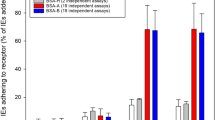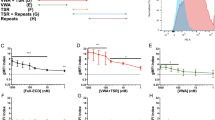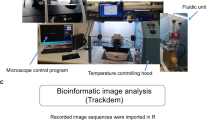Abstract
Excessive binding of Plasmodium falciparum-infected red blood cells (pRBCs) to the vascular endothelium (cytoadherence) and to uninfected erythrocytes (rosetting) may lead to occlusion of the microvasculature and thereby contribute directly to the acute pathology of severe human malaria1,2. A number of endothelial receptors have been identified as targets for the pRBCs, including CD36, intercellular adhesion molecule-1 (ICAM-1) and chondroitin-4-sulfate (CSA)3–5. In vitro, CD36 is the most frequent target of strains from patients with mild as well as severe P. falciparum malaria, but is expressed at low levels on the cerebral microvasculature6 and therefore seems unlikely to be involved in the evolution of cerebral disease. Strains of P. falciparum that form rosettes are associated both with the occurrence of cerebral malaria and severe anemia7–9. Here we report that malaria-infected RBCs adhere to platelet/endothelial cell adhesion molecule-1 (PECAM-1/CD31) on the vascular endothelium. pRBCs bind to endothelial cells, to PECAM-1/CD31 transfected cells, and directly to recombinant PECAM-1/CD31 absorbed onto plastic. Soluble PECAM-1/CD31 and monoclonal antibodies specific for the amino-terminal segment of PECAM-1/CD31 (domains 1–4) blocked the binding. Interferon- γ (IFN-γ) — essential for the development of cerebral malaria in the mouse —was found to augment adhesion of human pRBCs to PECAM-1/CD31 on endothelial cell monolayers. Our results suggest that PECAM-1/CD31 is a virulence-associated endothelial receptor of P. falciparum-infected RBCs.
This is a preview of subscription content, access via your institution
Access options
Subscribe to this journal
Receive 12 print issues and online access
$209.00 per year
only $17.42 per issue
Buy this article
- Purchase on Springer Link
- Instant access to full article PDF
Prices may be subject to local taxes which are calculated during checkout
Similar content being viewed by others
References
Wahlgren, M., Fernandez, V., Scholander, C. & Carlson, J. Rosetting. Parasitol. Today 10, 73–79 (1994).
Miller, L.H., Good, M.F. & Milon, G. Malaria pathogenesis. Science 264, 1878–1883 (1994).
Berendt, A.R., Simmons, D.L., Tansey, J., Newbold, C.I. & Marsh, K. Intercellular adhesion molecule-1 is an endothelial cell adhesion receptor for Plasmodium falciparum. Nature 341, 57–59 (1989).
Ockenhouse, C.F., Tandon, N.N., Magowan, C., Jamieson, G.A. & Chulay, J.D. Identification of a platelet membrane glycoprotein as a falciparum malaria sequestration receptor. Science 243, 1469–1471 (1989).
Robert, C. et al. Chondroitin-4-sulphate (proteoglycan), a receptor for Plasmodium falciparum-infected erythrocyte adherence on brain microvascular endothelial cells. Res. Immunol. 146, 383–393 (1995).
Turner, G.D.H. et al. An immunohistochemical study of the pathology of fatal malaria. Am. J. Pathol. 145, 1057–1069 (1994).
Carlson, J., et al. Human cerebral malaria: Association with erythrocyte rosetting and lack of anti-rosetting antibodies. Lancet 336, 1457–1460 (1990).
Treutiger, C.J. et al. Rosette formation in Plasmodium falciparum isolates and anti-rosette activity of sera from Gambians with cerebral or uncomplicated malaria. Am. J. Trop. Med. Hyg. 46, 503–510 (1992).
Rowe, A., Obeiro, J., Newbold, C.I. & Marsh, K. Plasmodium falciparum rosetting is associated with malaria severity in Kenya. Infect. Immun. 63, 2323–2326 (1995).
Wilson, G.A. ed. Fundamental Facts, Cell Adhesion Molecules. 42–46 (R&D Systems, Minneapolis, MN, 1996).
Newman, P.J., et al. PECAM-1 (CD31) cloning and relation to adhesion molecules of the immunoglobulin gene superfamily. Science 247, 1219–1222 (1990).
Muller, W.A., Berman, M.E., Newman, P.J., DeLisser, H.M. & Albelda, S.M. A heterophilic adhesion mechanism for platelet/endothelial cell adhesion molecule 1 (CD31). J. Exp. Med. 175, 1401–1404 (1992).
Liao, F., et al. Migration of monocytes across endothelium and passage through extracellular matrix involve separate molecular domains of PECAM-1. J. Exp. Med. 182, 1337–1343 (1995).
Liao, F., Jahanara, A., Greene, T. & Muller, W.A. Soluble domain 1 of platelet-endothelial cell adhesion molecule (PECAM) is sufficient to block transendothelial migration in vitro and in vivo. J. Exp. Med. 185, 1349–1357 (1997).
Sun, Q.-H. et al. Individually distinct Ig homology domains in PECAM-1 regulate homophilic binding and modulate receptor affinity. J. Biol. Chem. 271, 11090–11098 (1996).
DeLisser, H.M. et al. PECAM-1 (CD31)-mediated cellular aggregation involves cell surface glycosaminoglycans. J. Biol. Chem. 268, 16037–16046 (1993).
Muller, W.A. CD31 Workshop Panel report. in Leukocyte typing VI. Proceedings of the VIth International Workshop on Leukocyte Differentiation Antigens. (Garland Publishing, Inc., New York, 1997).
Muller, W.A., Greene, T. & Liao, F. CD31 Workshop: Transendothelial migration and interstitial migration of monocytes are mediated by separate domains of monocyte CD31. in Leukocyte Typing VI. Proceedings of the VIth International Workshop on Leukocyte Differentiation Antigens (Garland Publishing, New York, 1997).
Scholander, C., Treutiger, C.J., Hultenby, K. & Wahlgren, M. Novel fibrillar structure confers adhesive property to malaria-infected erythrocytes. Nature Med. 2, 204–208 (1996).
Romer, L.H., Mclean, N.V., Yan, H.-C., Sun, J. & DeLisser, H.M. IFN-γ and TNF-α induce redistribution of PECAM-1 (CD31) on human endothelial cells. J. Immunol. 154, 6582–6592 (1995).
Rudin, W., Favre, N., Bordmann, G. & Ryffel, B. Interferon-γ is essential for the development of cerebral malaria. Eur. J. Immunol. 27, 810–815 (1997).
Tang, Q. & Hendricks, R.L. Interferon gamma regulates platelet endothelial cell adhesion molecule 1 expression and neutrophil infiltration into herpes simplex virus-infected corneas. J. Exp. Med. 184, 1435–1447 (1996).
Brewster, D.R., Kwiatkowski, D. & White, N.J. Neurological sequelae of cerebral malaria in children. Lancet 336, 1039–1043 (1990).
Trager, W. & Jensen, J.B. Human malaria parasites in continuous culture. Science 193, 673–675 (1976).
Jaffe, E.A., Nachman, R.L., Becker, C.G. & Minick, C.R. Culture of human endothelial cells derived from umbilical veins. Identification by morphological and immunological criteria. J. Clin. Invest. 52, 2745–2756 (1973).
Udeinya, I.J., Schmidt, J.A., Aikawa, M., Miller, L.H. & Green, I. Falciparum malaria-infected erythrocytes specifically bind to cultured human endothelial cells. Science 213, 555–557 (1981).
Muller, W.A., Weigl, S.A., Deng, X. & Phillips, D.M. PECAM-1 is required for transendothelial migration of leukocytes. J. Exp. Med. 178, 449–460 (1993).
Author information
Authors and Affiliations
Corresponding author
Rights and permissions
About this article
Cite this article
Treutiger, C., Heddini, A., Fernandez, V. et al. PECAM-1/CDS31, an endothelial receptor for binding Plasmodium falciparum-infected erythrocytes. Nat Med 3, 1405–1408 (1997). https://doi.org/10.1038/nm1297-1405
Received:
Accepted:
Issue Date:
DOI: https://doi.org/10.1038/nm1297-1405
This article is cited by
-
ICAM-1 Kilifi variant is not associated with cerebral and severe malaria pathogenesis in Beninese children
Malaria Journal (2022)
-
Age-dependent increase in antibodies that inhibit Plasmodium falciparum adhesion to a subset of endothelial receptors
Malaria Journal (2019)
-
Children with cerebral malaria or severe malarial anaemia lack immunity to distinct variant surface antigen subsets
Scientific Reports (2018)
-
Host factors that modify Plasmodium falciparum adhesion to endothelial receptors
Scientific Reports (2017)
-
New var reconstruction algorithm exposes high var sequence diversity in a single geographic location in Mali
Genome Medicine (2017)



